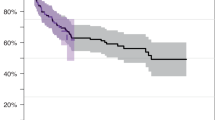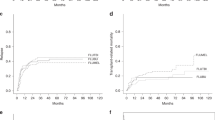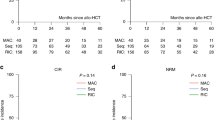Abstract
CLL remains incurable with the standard therapy. Allogeneic hematopoietic stem cell transplant may be curative. We examined 50 patients with advanced CLL who underwent allogeneic HCT at the University of Michigan between 1996 and 2006. Twenty-one patients received reduced-intensity conditioning (RIC) and twenty-nine patients received full-intensity conditioning (FIC) consisting of CY, etoposide and BCNU (n=20) or BU and CY (n=9). RIC recipients were older than FIC recipients (median age 54 vs 51, P=0.009). There were no statistically significant differences between groups in terms of the number of earlier therapies or patients with adverse cytogenetics. There were more unrelated donors in the RIC group 62% than in the FIC group 31% (P=0.030). Despite their older age and greater use of URD, the 5-year overall survival (OS) rate was 63% in the RIC group as compared with 18% in the FIC group (P=0.006). The primary cause of inferior survival in the FIC recipients was TRM, which was twice as high at day 100 for the FIC group 27% compared with the RIC group 14% (P=0.005). The relapse rate was 15% regardless with the majority of relapses occurring after day 100. These results suggest a favorable outcome for advanced CLL who undergo a RIC regimen compared with FIC.
This is a preview of subscription content, access via your institution
Access options
Subscribe to this journal
Receive 12 print issues and online access
$259.00 per year
only $21.58 per issue
Buy this article
- Purchase on Springer Link
- Instant access to full article PDF
Prices may be subject to local taxes which are calculated during checkout



Similar content being viewed by others
References
Keating MJ, Flinn I, Jain V, Binet JL, Hillmen P, Byrd J et al. Therapeutic role of alemtuzumab (Campath-1H) in patients who have failed fludarabine: results of a large international study. Blood 2002; 99: 3554–3561.
Byrd JC, Rai K, Peterson BL, Appelbaum FR, Morrison VA, Kolitz JE et al. Addition of rituximab to fludarabine may prolong progression-free survival and overall survival in patients with previously untreated chronic lymphocytic leukemia: an updated retrospective comparative analysis of CALGB 9712 and CALGB 9011. Blood 2005; 105: 49–53.
Keating MJ, O'Brien S, Albitar M, Lerner S, Plunkett W, Giles F et al. Early results of a chemoimmunotherapy regimen of fludarabine, cyclophosphamide, and rituximab as initial therapy for chronic lymphocytic leukemia. J Clin Oncol 2005; 23: 4079–4088.
Wierda W, O'Brien S, Wen S, Faderl S, Garcia-Manero G, Thomas D et al. Chemo-immunotherapy with fludarabine, cyclophosphamide, and rituximab for relapsed and refractory chronic lymphocytic leukemia. J Clin Oncol 2005; 23: 4070–4078.
Gribben JG, Zahrieh D, Stephans K, Bartlett-Pandite L, Alyea EP, Fisher DC et al. Autologous and allogeneic stem cell transplantations for poor-risk chronic lymphocytic leukemia. Blood 2005; 106: 4389–4396.
Pavletic ZS, Bierman PJ, Vose JM, Bishop MR, Wu CD, Pierson JL et al. High incidence of relapse after autologous stem-cell transplantation for B-cell chronic lymphocytic leukemia or small lymphocytic lymphoma. Ann Oncol 1998; 9: 1023–1026.
Esteve J, Montserrat E, Dreger P . Stem cell transplantation for chronic lymphocytic leukemia: outcome and prognostic factors after autologous and allogeneic transplants. Am Soc Hematol Annu Conf 2001; 482 (Abstract).
Dreger P, Brand R . Prognostic factors for survival after autologous stem cell transplantation for chronic lymphocytic leukemia: the EBMT experience. Am Soc Hematol Annu Conf 2000; 482 (Abstract).
Ritgen M, Lange A, Stilgenbauer S, Dohner H, Bretscher C, Bosse H et al. Unmutated immunoglobulin variable heavy-chain gene status remains an adverse prognostic factor after autologous stem cell transplantation for chronic lymphocytic leukemia. Blood 2003; 101: 2049–2053.
Pavletic ZS, Arrowsmith ER, Bierman PJ, Goodman SA, Vose JM, Tarantolo SR et al. Outcome of allogeneic stem cell transplantation for B cell chronic lymphocytic leukemia. Bone Marrow Transpl 2000; 25: 717–722.
Khouri IF, Keating MJ, Saliba RM, Champlin RE . Long-term follow-up of patients with CLL treated with allogeneic hematopoietic transplantation. Cytotherapy 2002; 4: 217–221.
Michallet M, Archimbaud E, Bandini G, Rowlings PA, Deeg HJ, Gahrton G et al. HLA-identical sibling bone marrow transplantation in younger patients with chronic lymphocytic leukemia. European Group for Blood and Marrow Transplantation and the International Bone Marrow Transplant Registry. Ann Int Med 1996; 124: 311–315.
Khouri IF, Keating MJ, Vriesendorp HM, Reading CL, Przepiorka D, Huh YO et al. Autologous and allogeneic bone marrow transplantation for chronic lymphocytic leukemia: preliminary results. J Clin Oncol 1994; 12: 748–758.
Gribben JG . Salvage therapy for CLL and the role of stem cell transplantation. Hematol Am Soc Hematol Educ Program 2005, 292–298.
Montserrat E, Moreno C, Esteve J, Urbano-Ispizua A, Ginć E, Bosch F . How I treat refractory CLL. Blood 2006; 107: 1276–1283.
Ritgen M, Stilgenbauer S, von Neuhoff N, Humpe A, Brüggemann M, Pott C et al. Graft-versus-leukemia activity may overcome therapeutic resistance of chronic lymphocytic leukemia with unmutated immunoglobulin variable heavy-chain gene status: implications of minimal residual disease measurement with quantitative PCR. Blood 2004; 104: 2600–2602.
Sorror ML, Maris MB, Sandmaier BM, Storer BE, Stuart MJ, Hegenbart U et al. Hematopoietic cell transplantation after nonmyeloablative conditioning for advanced chronic lymphocytic leukemia. J Clin Oncol 2005; 23: 3819–3829.
Caballero D, García-Marco JA, Martino R, Mateos V, Ribera JM, Sarrá J et al. Allogeneic transplant with reduced intensity conditioning regimens may overcome the poor prognosis of B-cell chronic lymphocytic leukemia with unmutated immunoglobulin variable heavy-chain gene and chromosomal abnormalities (11q- and 17p-). Clin Cancer Res 2005; 11: 7757–7763.
Dreger P, Brand R, Milligan D, Corradini P, Finke J, Lambertenghi Deliliers G et al. Reduced-intensity conditioning lowers treatment-related mortality of allogeneic stem cell transplantation for chronic lymphocytic leukemia: a population-matched analysis. Leukemia 2005; 19: 1029–1033.
Brown JR, Kim HT, Li S, Stephans K, Fisher DC, Cutler C et al. Predictors of improved progression-free survival after nonmyeloablative allogeneic stem cell transplantation for advanced chronic lymphocytic leukemia. Biol Blood Marrow Transpl 2006; 12: 1056–1064.
Przepiorka D, Weisdorf D, Martin P, Klingemann HG, Beatty P, Hows J et al. 1994 Consensus conference on acute GVHD grading. Bone Marrow Transpl 1995; 15: 825–828.
Molina AJ, Storb R . Hematopoietic stem cell transplantation in older adults. In: Rowe JM, Carella AM (eds). Handbook of Bone Marrow Transplantation. Martin Dunitz Ltd: London, UK, 2000, pp 111–137.
Author information
Authors and Affiliations
Corresponding author
Rights and permissions
About this article
Cite this article
Peres, E., Braun, T., Krijanovski, O. et al. Reduced intensity versus full myeloablative stem cell transplant for advanced CLL. Bone Marrow Transplant 44, 579–583 (2009). https://doi.org/10.1038/bmt.2009.61
Received:
Revised:
Accepted:
Published:
Issue Date:
DOI: https://doi.org/10.1038/bmt.2009.61
Keywords
This article is cited by
-
Pushing the envelope—nonmyeloablative and reduced intensity preparative regimens for allogeneic hematopoietic transplantation
Bone Marrow Transplantation (2015)
-
Long-term follow-up of reduced-intensity allogeneic stem cell transplantation for chronic lymphocytic leukemia: prognostic model to predict outcome
Leukemia (2013)
-
High incidence of chronic graft-versus-host disease after myeloablative allogeneic stem cell transplantation for chronic lymphocytic leukemia in Sweden: graft-versus-leukemia effect protects against relapse
Medical Oncology (2013)
-
Comparing efficacy of reduced-toxicity allogeneic hematopoietic cell transplantation with conventional chemo-(immuno) therapy in patients with relapsed or refractory CLL: a Markov decision analysis
Bone Marrow Transplantation (2012)
-
Reduced-intensity allografting in patients with therapy-related myeloid neoplasms and active primary malignancies
Bone Marrow Transplantation (2011)



